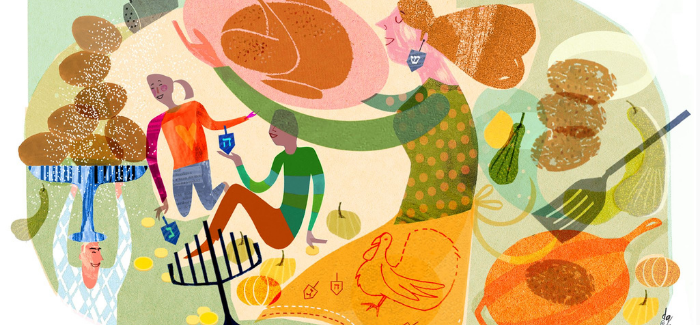Being Jewish
Commentary
When Thanksgiving Spills Into Hanukkah

“An apology to the hundreds Who Were Turned Away on Thanksgiving,” read a 1920 advertisement for Garfein’s, a kosher restaurant in New York City. Placed in The Hebrew Standard, the ad explained that the restaurant had so many patrons on Thanksgiving that it ran out of food. The solution was simple: The Thanksgiving menu would be repeated at a reduced price of $1.75 on Hanukkah, which began 10 days later that year.
Thanksgiving has long captured both the hearts and stomachs of Jewish Americans, akin to a patriotic fall seder. Indeed, when the Garfein’s ad ran 100 years ago, it highlighted the centrality of the American holiday over Hanukkah, which at the time seemed more of an afterthought.
As early as 1857, Jewish newspapers carried proclamations from government officials with their good wishes for Thanksgiving. In 1888, St. Louis’s B’nai El Ladies’ Aid Society hosted a “Grand Thanksgiving Ball,” which evolved into an annual event. The late 1800s saw ads in Jewish periodicals for Thanksgiving décor—from tablecloths to chafing dishes. By the early 1900s, Thanksgiving had earned a sacred place on the Jewish American calendar, well before Hanukkah’s surge in popularity in the 1930s and the post-war years.
This year, we encounter a rare phenomenon: Hanukkah begins on November 28, the Sunday night after Thanksgiving. How will our observance of Hanukkah be impacted by its proximity to Thanksgiving?
This holiday duality reminds me of the Talmudic debate between Beit Hillel and Beit Shammai about how to light the Hanukkah candles. Beit Shammai advocates for lighting eight candles on the first night and lighting one fewer candle each subsequent night. Beit Hillel suggests that we start with one candle on the first night and add an additional candle each night. The halacha, Jewish law, is in accordance with Beit Hillel, as the Talmud explains, “ma’alin ba’kodesh v’ain moridin,” (“we go up in [matters of] holiness and we do not go down,”) (Shabbat 21b). We add joy to and never diminish our celebrations.
By adding candles each night, we are reminded that we can always aspire to bring more kedushah, holiness, into our homes. This year, while we might be exhausted after our grand Thanksgiving feast, my hope is that we can extend the Talmudic dictate of “ma’alin ba’kodesh” to begin at Thanksgiving itself.
The most recent Thanksgiving/Hanukkah overlap, in 2013, is a great example of a modern “ma’alin ba’kodesh” moment. Dubbed Thanksgivukkah by Dana Reichman Gitell, a marketing specialist in Massachusetts, the coinciding holidays featured not only a combined festival but also a slew of Jewish “fast fashion” products—from commemorative T-shirts to a “menurkey,” a turkey-shaped menorah. The merging of the two observances elevated both.
How can we bring more holiness into this year’s Thanksgiving/Hanukkah proximity? As we’ve learned through the pandemic, Jewish rituals observed in the home are thriving. Indeed, many of us have boosted these rituals through a new kind of DIY Judaism, from creative holiday baking to crafting holiday décor.
Still, after a year-and-a-half of pandemic-inspired improvising, fatigue is setting in. Can we muster the energy to elevate each night leading up to—and during—Hanukkah?
If it’s safe to do so, we can invite family members who usually join us for Thanksgiving to stay through Sunday evening, so we can usher in Hanukkah together. The weekend could be centered around Thanksgiving/Shabbat/Hanukkah activities, from making gelt-stuffed pumpkin-flavored challah to a special havdalah surprise—pumpkin spice in the besamim holders (spice boxes). Saturday evening could feature a family latke-frying competition.
Let’s use the proximity of the holidays as a springboard to strengthen our identities as Jews in America. If the past century of American acculturation has taught us anything, it’s that we can have our pumpkin spice latkes and eat them, too.
Rabbi Yael Buechler is the lower school rabbi and outreach coordinator at the Leffell School in Westchester, N.Y., and founder of midrashmanicures.com.










 Facebook
Facebook Instagram
Instagram Twitter
Twitter
Miriam Rosenblum says
https://www.youtube.com/watch?v=6b6hnJhuZog
Back in 2013 when Hanukkah and Thanksgiving most recently collided, a Hanukkah parody was written to mark “Thanksgivukkuh”.